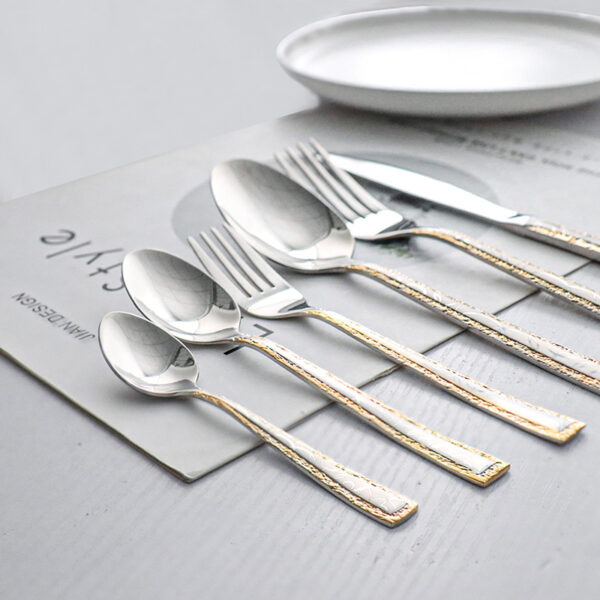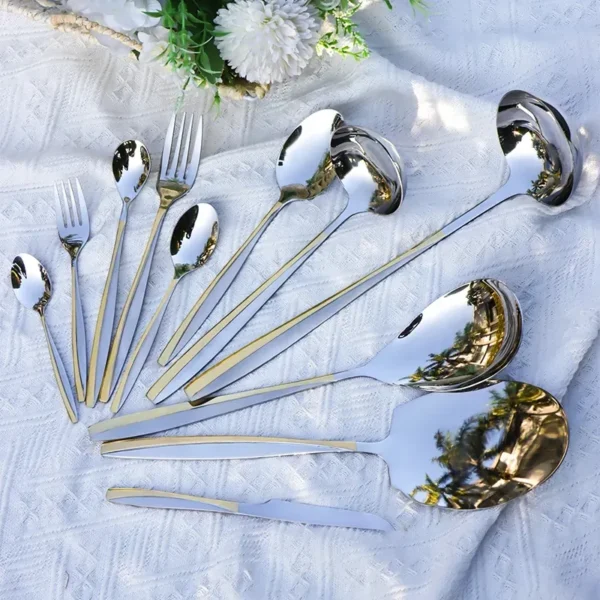Abstract
Defined, flatware, according to the Merriam-Webster dictionary, is relatively flat tableware. In particular, this vague definition refers to eating and serving utensils such as knives, forks, and spoons. However, the relationship between flatware and tableware is often misunderstood. While flatware is a component of tableware, the two terms are not synonymous. In this article, we will delve into the definitions, differences, uses, and contexts of flatware and tableware, and explore how they fit into our dining experiences.
Table of Contents
- Introduction
- Defining Flatware
- 2.1 Types of Flatware
- 2.2 Materials Used in Flatware
- Defining Tableware
- 3.1 Types of Tableware
- 3.2 Materials Used in Tableware
- Key Differences Between Flatware and Tableware
- The Role of Flatware in Dining
- Choosing the Right Flatware and Tableware
- Caring for Flatware and Tableware
- Conclusion
1. Introduction
When it comes to dining, the terms “flatware” and “tableware” are often thrown around casually. However, understanding the distinctions between these two categories can enhance our appreciation of the dining experience. While flatware plays a crucial role in how we eat and serve food, tableware encompasses a broader range of items that contribute to a complete dining setting.
In this blog post, we will explore the definitions of flatware and tableware, their differences, and how each contributes to our dining experiences. By gaining insight into these terms, you can make informed decisions when setting your table or purchasing dining essentials.

2. Defining Flatware
2.1 Types of Flatware
Flatware refers specifically to the utensils used for eating and serving food. This category typically includes:
-
Knives: Used for cutting and spreading. Common types include dinner knives, butter knives, and steak knives.
-
Forks: Used for spearing and lifting food. There are several types of forks, such as dinner forks, salad forks, and dessert forks.
-
Spoons: Used for scooping and serving. Types of spoons include soup spoons, dessert spoons, and serving spoons.
-
Serving Utensils: These include larger forks, ladles, and tongs used to serve food from platters to individual plates.
2.2 Materials Used in Flatware
Flatware can be made from a variety of materials, including:
-
Stainless Steel: The most common material for flatware due to its durability, resistance to rust, and ease of maintenance.
-
Silver: Sterling silver flatware is often used for formal dining and special occasions. It offers a classic and elegant aesthetic.
-
Plastic: Disposable plastic flatware is popular for casual gatherings, picnics, and outdoor events.
-
Bamboo or Wood: Eco-friendly options are available, with utensils made from sustainable materials that are ideal for specific dining settings.

3. Defining Tableware
3.1 Types of Tableware
Tableware is a broader category that encompasses all the items used to set a table and serve food. This includes:
-
Dinnerware: Plates, bowls, and saucers used for serving and eating food. Dinnerware comes in various styles, materials, and sizes.
-
Flatware: As mentioned above, this refers to the utensils used for eating and serving.
-
Glassware: This includes all types of drinking vessels, such as water glasses, wine glasses, and tumblers. Glassware varies in design, size, and functionality, enhancing the dining experience.
3.2 Materials Used in Tableware
Tableware can be crafted from a wide range of materials, including:
-
Ceramics and Porcelain: Common materials for dinnerware, known for their decorative qualities and durability. They can be glazed to create a glossy finish.
-
Glass: Used for both glassware and dinnerware, glass can be clear, colored, or frosted, adding elegance to any table setting.
-
Stoneware: A type of pottery known for its sturdiness, stoneware is often used for casual and rustic dining settings.
-
Melamine: A durable, lightweight plastic often used for outdoor dining and casual settings. Melamine can mimic the look of ceramics and is resistant to breakage.
-
Metal: Stainless steel, silver, and aluminum are used for serving dishes and drinkware, offering both functionality and aesthetic appeal.

4. Key Differences Between Flatware and Tableware
Understanding the distinctions between flatware and tableware can enhance our dining experiences. Here are the main differences:
-
Functionality: Flatware specifically refers to eating utensils (knives, forks, spoons) while tableware encompasses all items used to set the table, including dinnerware, glassware, and serveware.
-
Scope: Flatware is a subset of tableware. All flatware is tableware, but not all tableware is flatware. Tableware includes a wider range of items that contribute to the overall dining experience.
-
Material Variety: While flatware is often made from metals (such as stainless steel or silver), tableware can be made from various materials like ceramics, glass, and plastics, offering a broader range of options for style and functionality.
-
Setting the Table: Flatware is specifically arranged according to dining etiquette, while tableware includes plates, glasses, and other items that create the complete table setting.
5. The Role of Flatware in Dining
Flatware plays a crucial role in dining, influencing the way we eat and enjoy our meals. Here are some key aspects of its significance:
-
Cultural Importance: Different cultures have unique customs related to flatware use. For instance, in some cultures, chopsticks are preferred, while in others, forks and knives are the standard.
-
Dining Etiquette: The arrangement and use of flatware often follow specific etiquette rules. Knowing which utensils to use for various courses can enhance your dining experience and show respect for your guests.
-
Aesthetic Appeal: The style and design of flatware can significantly impact the overall look of a table setting. Elegant or unique flatware can elevate a dining experience, making meals feel more special.
-
Functional Use: Beyond aesthetics, flatware is essential for consuming food. The design and ergonomics of utensils can enhance comfort and ease while eating, making the dining experience more enjoyable.
6. Choosing the Right Flatware and Tableware
When selecting flatware and tableware, consider the following factors:
-
Style: Choose designs that reflect your personal taste and complement your home decor. Whether you prefer modern, rustic, or classic styles, there are plenty of options available.
- Durability: Consider the materials used in both flatware and tableware. Stainless steel flatware is known for its durability, while porcelain dinnerware may be more fragile. Ensure that the items you choose can withstand regular use, especially if you have children or host frequent gatherings.
-
Functionality: Think about how you will use your flatware and tableware. If you often host large dinners, you may want to invest in serveware that accommodates family-style meals. If you enjoy casual outdoor dining, durable melamine or plastic options might be the best fit.
-
Maintenance: Some materials require more care than others. For example, silver flatware needs regular polishing to avoid tarnishing, while stainless steel is generally low-maintenance and dishwasher-safe. Choose options that align with your lifestyle and willingness to care for them.
-
Budget: Dining essentials can vary widely in price. Set a budget and explore options within that range. Investing in high-quality flatware and tableware can enhance your dining experience and serve you well for years to come.

7. Caring for Flatware and Tableware
Proper care and maintenance of flatware and tableware are crucial to ensuring their longevity and maintaining their appearance. Here are some tips for keeping your dining essentials in great shape:
Caring for Flatware
-
Hand Washing: While many flatware sets are dishwasher-safe, hand washing with mild soap and warm water is often the best way to preserve their finish. Use a soft sponge to avoid scratches.
-
Avoiding Harsh Chemicals: Stay away from bleach or abrasive cleaners, as they can damage the finish of your flatware. Opt for gentle dish detergents instead.
-
Drying Immediately: After washing, dry your flatware immediately with a soft cloth to prevent water spots and corrosion.
-
Storage: Store flatware in a designated drawer or organizer to prevent scratching. Keep them separated from other utensils to maintain their quality.
Caring for Tableware
-
Dishwasher Use: Check if your dinnerware is dishwasher-safe. If it is, place it securely in the dishwasher to prevent chipping. For hand-wash items, use a soft cloth or sponge to clean them gently.
-
Avoiding Extreme Temperatures: Be cautious with temperature changes, especially with glass and ceramic items. Avoid transferring hot items directly to cold surfaces, as this can cause cracking.
-
Inspection: Regularly inspect your tableware for any chips or cracks. Addressing these issues early can prevent further damage and maintain the integrity of your items.
-
Storage: Store plates and bowls stacked carefully to avoid chipping. Use protective padding between stacked items if necessary.
8. Conclusion
In summary, while flatware is a vital component of tableware, the two terms are not interchangeable. Flatware specifically refers to the utensils used for eating and serving, such as knives, forks, and spoons, while tableware encompasses a broader range of dining items, including dinnerware, glassware, and serveware.
Understanding the distinctions between flatware and tableware can enhance not only your dining experience but also your appreciation for the art of setting a table. Whether you’re hosting a formal dinner party or enjoying a casual meal with family, the right flatware and tableware can elevate the experience and create an inviting atmosphere.
When selecting your dining essentials, consider factors such as style, durability, functionality, maintenance, and budget. With the right choices, you can create a beautiful and functional table setting that reflects your personal taste and enhances your meals.






